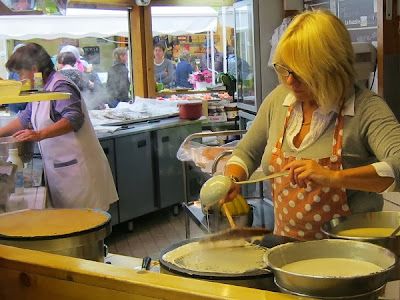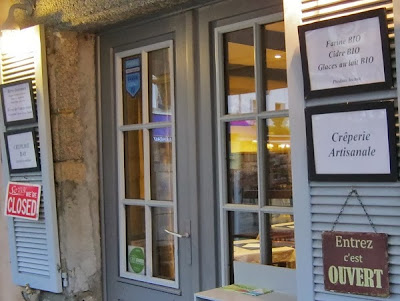Saturday 19th October 2013, Concarneau
We moved on this morning, making our way around southern Brittany. Concarneau was the nearest campsite still open so late in the season and we were anxious to arrive before dusk in case it had decided to close earlier than advertised. This is always a risk we face and if so we’d need to decide what to do for the night.
First though we would visit Quimper, capital of Finisterre. Although we have been before neither of us had much recollection of what was there, other than a cathedral and the famed Quimper faience works at Locmaria where ceramics are produced and hand painted with traditional Breton designs.
We found Quimper to be very pleasant on a bustling Saturday morning. There was a large covered market selling fresh fruit and vegetables as well as fresh fish, crabs, lobsters and prawns. Of course there were pancakes being made and sold, served with the local cider. Never have we seen so many pancake houses clustered together! I guess other things must be eaten but we saw almost nothing else! Going native we bought a bottle of cider and half a dozen pancakes to use for our supper this evening.
While browsing the extensive outdoor market selling everything from double beds to memory foam innersoles, the heavens opened and, with a crash of thunder, everyone and everything was well and truly soaked. Pausing only to help a stall cover his rolls of fabric with a huge plastic sheet we ran to the nearest shop and developed a sudden and short-lived fascination for gold boots with sequins on until the rain eased enough for us to puddle jump over the cobbles back to the covered market for a lunch at one of the stalls of fresh pasta with ham, potimarron and parmesan. By this time the cathedral had reopened after the two hour lunch break – even saints and angels need a lunch break in France it seems.
The cathedral is built on the skew. There is an odd bend between the nave and the choir. The windows apparently have glass dating from the 15th century. It has twin towers added in the 19th century. Typical of Breton clochers they give an impression of lightness with daylight shining right through the bell towers.
Outside the cathedral a campaign to eradicate cancer from Finisterre was in full swing supported by a Latin American group singing and playing salsa music while couples danced on the cathedral parvis. It was all very lively and the band was excellent. We thoroughly enjoyed it all.
Old Quimper is a network of pedestrianised cobbled footways with half-timbered wooden houses overhanging the streets. They are used as bookshops, stationers, select restaurants, tea shops - announcing “le nouveau thé de noël est arrivé”, glorious patisseries filled with macaroons in every colour of the rainbow and expensive chocolateries with gorgeous Halloween window displays of chocolate ghouls, witches, ghosts and pumpkins.
Quimper stands at the confluence of three different rivers. Indeed the name in Breton – Kemper – means confluence. It has several museums including fine arts, local history and ceramics. All were closed for the obligatory two hour lunch break in the core of the day!! The French really have an incomprehensible attitude to work!!
Leaving Quimper mid afternoon – just as the museums reopened – we drove to Concarneau on the south coast of Brittany. It is France’s third largest fishing port. (Rather an odd name considering “Concarneau” more or less means “with meat”.) The campsite reception was closed until 5pm – another long lunch break – but it was obviously still open. So we drove to the sea and went for a paddle in the surf – yes, even Ian! The sun had returned, the sky was a brilliant blue, the sand was fine and white and all was well with the world. Refreshed we rubbed the sand from our feet and went for a walk along the coastal footpath until it was time to return to the campsite. Our pitch overlooks the sea. There is even a pool if we want to use it. From the site a footpath leads down into Concarneau. We will explore it tomorrow.
Meanwhile we sat outside with our bottle of Breton cider enjoying the warmth of the evening sunshine – the extra hour’s daylight makes a huge difference at this time of year, you’d have all been turning on the lights and drawing the curtains back in Devon.
This evening Remoska presented for our delectation Breton pancakes filled with ham and braised vegetables – tomatoes, onions and carrots (all from our garden) topped with a cheese sauce. As the cider was sparkling and the cork impossible to replace we drank more than we intended, and the Breton pancakes were incredibly huge and filling! Our gourmandise has left us feeling very sleepy and together with the soporific sound of the sea, has us falling asleep before we’ve even made up our bed for the night. So sleep well everyone. We certainly shall.
Sunday 20th October 2013, Concarneau
It has been another very pleasant day though my poor feet are so sore with all the walking we do! This morning it was still boisterously windy but mild and sunny. We walked down into the centre of town through fields and along a disused railway track to emerge at the port near the old fort with the “ville close” within. This is definitely the most attractive part of the town. The strong granite walls of the fort form one part of the harbour walls. It looked pretty impregnable to us. Around the outside of the walls small sailing craft bobbed on the waves while within the cobbled streets were sheltered from the wind. Most of the pretty granite houses are now used as shops selling Breton goods – cider, mead, boxes of Breton biscuits, nautical wear, teeshirts embroidered with triskels, Quimper ceramics, trays decorated with Celtic and Breton motifs and many other tasteful, quality souvenirs. It was all very pleasant and we enjoyed browsing the shops which also provided us with shelter during a sudden heavy shower. We walked around the windswept ramparts offering excellent views over the harbour and seafront. The fishing museum would have been interesting to explore but it opens at 10, stops issuing tickets at 11 and closes at 12.30 until 2. No wonder it doesn’t have many visitors! Having no wish to hang around until 2pm we went off and found a bar for a ham sandwich and coffee before exploring the port and the sea shore.
Here were egrets, cormorants and gulls and nearly all of them had their beaks full of wriggling things. We watched astonished as a gull tried to work out the best way of swallowing an eel about a foot long that twisted and wriggled in the mud. Several times he half swallowed it before it wriggled free. Eventually he gulped it down and even the tail disappeared. Still it heaved inside the gull’s throat until the bird opened its beak slightly and the eel flopped back onto the rocks. Once again the gull struggled with it until eventually it again disappeared down the gull’s throat. This time the bird kept its beak firmly closed.
We returned to our camp site along the sea front where there were some delightful seaside houses dating from the Belle Epoque with large windows overlooking the sea. By the time we reached the Modestine I was fit only to fall asleep for half an hour. I don’t seem to have Ian’s boundless energy any more. Still I recovered quickly and after a coffee we cut ourselves free from the electric supply, wound up the supports and Modestine took us for a drive along the coast. Soon we encountered the very pleasant bourg of La Forêt Fouesnant. From here a walk led along beside a tidal river to the old port. This is a massive yaching marina with countless white sailing boats moored up, all with their sails furled. The wind was singing through the wires of hundreds of windlasses and spinnakers (makes me sound as if I know what I’m talking about) making them flap, whistle and tinkle in unison. The sea has been very rough over the last couple of days so the port was particularly full today as sailing craft sheltered from the turbulent waves.
Tide was coming in and it needs to pass through a narrow channel spanned by a bridge. The force with which it poured upstream beneath the bridge was quite awesome. Further up, near the bourg, were several swans floating peacefully. The river water must be brackish but the salt didn’t seem to bother the swans.
We returned back through a forest of sweet chestnuts and our pockets were soon bulging. Once we reached the campsite and hooked Modestine up to her umbilical cord again we devised a way to cook them in Remoska along with our supper. It worked rather well and the chestnuts were all sound and sweet.
Related links
Quimper
Concarneau





























